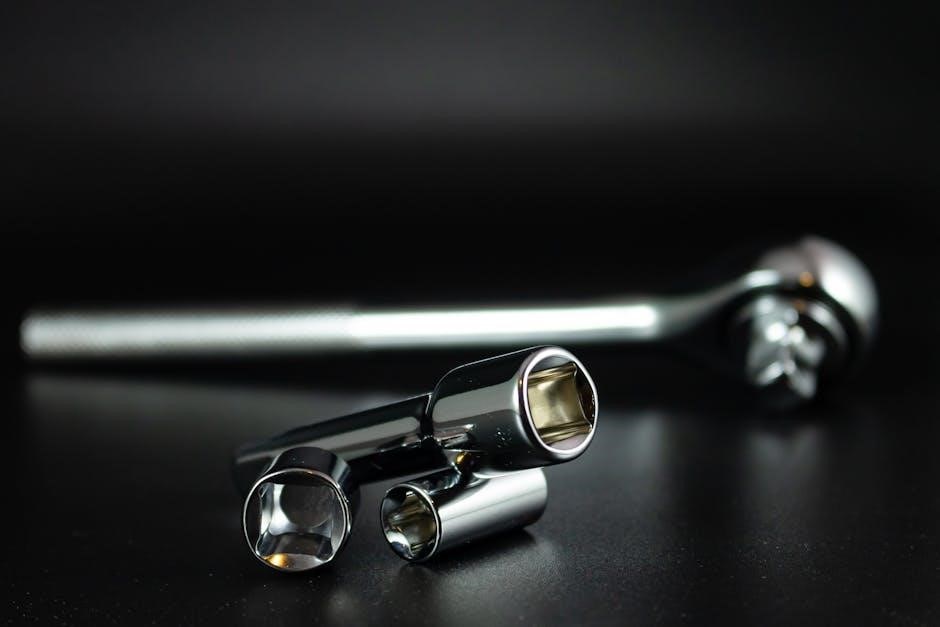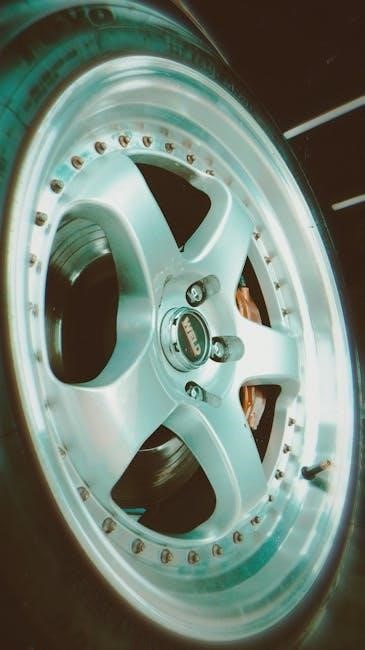This guide provides essential information on lug nut torque, ensuring proper wheel security and vehicle safety. Proper torque prevents wheel failure and damage, while incorrect torque can lead to dangerous consequences.
1.1 Importance of Proper Lug Nut Torque
Proper lug nut torque ensures wheel safety and vehicle stability. It prevents wheel failure, maintains even stress distribution, and safeguards against damage to brake components and wheel studs. Correct torque values are vital for optimal performance and security.
1.2 Consequences of Improper Torque
Improper lug nut torque can lead to wheel failure, brake rotor warping, and loose wheels, posing serious safety risks. Over-tightening may damage studs or hubs, while under-tightening risks wheel separation. Both scenarios endanger vehicle stability and safety, potentially causing accidents or costly repairs.

Factors Affecting Lug Nut Torque Specifications
Vehicle make, model, bolt size, and wheel material influence torque values. These factors ensure proper fitment and prevent damage, varying across different vehicles for safety and performance.
2.1 Bolt Size and Type
Bolt size and type significantly impact torque specifications. Larger bolts require higher torque for proper clamping force, while smaller bolts need less to avoid damage. Metric and SAE bolt standards differ, affecting torque values. Material strength, such as steel or aluminum, also influences torque requirements, ensuring optimal performance and safety without over-tightening or under-tightening.
2.2 Vehicle Make and Model
Vehicle make and model determine specific torque specifications due to variations in wheel size, brake systems, and chassis design. Luxury or performance vehicles may require higher torque values for added stability and safety. Always consult the manufacturer’s guidelines for precise torque recommendations tailored to your vehicle’s unique characteristics to ensure optimal performance and reliability.
2.3 Wheel and Hub Material
Wheel and hub material significantly influence torque specifications. Aluminum wheels may require less torque than steel wheels to avoid damage. Similarly, hubs made of alloy or composite materials have unique torque needs. Always follow manufacturer guidelines, as improper torque can lead to material stress or failure, compromising both safety and performance.

Tools Required for Torque Application
A torque wrench, socket, and breaker bar are essential tools. The torque wrench ensures precise torque application, while the socket fits the lug nut, and the breaker bar provides extra leverage.
3.1 Torque Wrench
A torque wrench is crucial for applying precise torque to lug nuts. It measures and limits the force applied, ensuring accurate tightening without over-torquing. Digital or mechanical models are available, offering reliability and ease of use. Proper calibration is essential for accurate readings and safe application.
3.2 Socket Size and Type
Selecting the correct socket size and type is vital for securely fitting lug nuts. Sockets must match the bolt head size to prevent rounding. Impact sockets are recommended for high-torque applications, while chrome sockets offer durability. Using the wrong socket can damage lug nuts or strip threads, compromising wheel safety. Proper fit ensures effective torque application.
3.3 Breaker Bar or Extension
A breaker bar or extension enhances leverage for loosening stubborn lug nuts. longer bars provide more torque but require caution to avoid over-tightening. Extensions adapt tools for hard-to-reach bolts. Using these accessories ensures proper torque application without damaging studs or wheels, promoting safe and effective lug nut maintenance and removal.
Step-by-Step Guide to Torque Application
Secure your vehicle on jack stands. Loosen lug nuts with a breaker bar. Tighten in a star pattern using a torque wrench. Verify torque settings for accuracy and safety to ensure proper wheel installation and prevent potential damage or failure while driving.

4.1 Loosening Lug Nuts Safely
Before loosening, ensure the vehicle is securely lifted on jack stands and in park. Apply penetrating oil if lug nuts are stuck. Use a breaker bar with a socket to gently break the nuts loose. Avoid extreme force to prevent stripping or rounding. Turn counterclockwise until snug, but do not remove entirely during loosening.
4.2 Tightening Lug Nuts in Star Pattern
Tighten lug nuts using a torque wrench in a star pattern to ensure even pressure. Start with one lug nut, move to the next in a diagonal sequence, and repeat until all are snug. Avoid overtightening in one spot, as this can cause uneven stress. Follow the manufacturer’s torque specifications for your vehicle’s wheel studs to prevent damage or wheel failure.

4.3 Final Torque Check
After tightening in a star pattern, perform a final torque check. Use a torque wrench to ensure each lug nut meets the manufacturer’s specifications. This step confirms even pressure and prevents future issues. It’s a critical safety measure to avoid wheel damage or loose wheels while driving.

Common Mistakes to Avoid
Over-tightening, using incorrect torque values, and neglecting regular checks are common errors. These mistakes can lead to wheel damage or loose nuts, compromising safety and performance.
5.1 Over-Tightening Lug Nuts
Over-tightening can damage wheels, brake rotors, or wheel studs. It may also strip threads, leading to costly repairs. Always use a torque wrench and avoid excessive force to prevent such issues.
5.2 Using Incorrect Torque Values
Using incorrect torque values can lead to wheel failure or damage to wheel studs and brake rotors. Always refer to your vehicle’s specifications to ensure accuracy. Incorrect torque can result in loose or over-tightened lug nuts, compromising safety and performance. A torque wrench is essential for precise application.
5.3 Neglecting Regular Retightening
Neglecting regular retightening of lug nuts can cause them to loosen over time, leading to wheel instability or detachment while driving. This can result in loss of control and potential accidents, making it crucial to check torque at recommended intervals to ensure safety and prevent damage.

When to Retorque Lug Nuts
Retorque lug nuts after initial installation, following the recommended break-in period, and during seasonal or mileage-based checks to ensure wheel security and prevent loosening over time.
6.1 After Initial Installation
Retorque lug nuts after initial installation, typically within 50 to 100 miles, to ensure proper seating and prevent loosening. Use a torque wrench and follow manufacturer specifications for precise torque values, ensuring long-term wheel security and safety on the road.
6.2 After Driving Break-In Period
Recheck the torque of your lug nuts after the driving break-in period to ensure they remain within the specified range. This step is crucial for maintaining proper wheel security and preventing potential issues that may arise from driving conditions. Use a torque wrench to verify the torque values, ensuring safety and optimal vehicle performance.
6.4 Seasonal or Mileage-Based Checks
Regularly inspect and re-torque your lug nuts based on seasonal changes or high mileage. Extreme temperatures and driving conditions can affect torque values. Use a torque wrench to ensure consistency and safety. Seasonal checks help maintain proper wheel security and prevent issues related to weather-induced wear and tear. Consistency is key to optimal performance.

Safety Tips for Lug Nut Torque
Always use a torque wrench to avoid over-tightening, which can damage wheels or brakes. Never use anti-seize or lubricants on lug nuts, as this can compromise safety and torque accuracy.
7.1 Avoiding Wheel Stud Damage
Wheel studs can be damaged by over-torquing or improper tightening patterns. Always use a torque wrench and tighten in a star pattern to distribute force evenly. Avoid using lubricants or anti-seize, as they can reduce friction and lead to inaccurate torque readings, increasing the risk of damage or stud failure.
7.2 Preventing Brake Rotor Warping
Brake rotor warping can occur due to excessive heat from over-torqued or unevenly tightened lug nuts. Always use the correct torque value and tighten in a star pattern. Avoid sudden braking or aggressive driving, as this generates heat. Loosen lug nuts in the correct order when removing wheels to prevent rotor bending.
7.3 Ensuring Wheel Security
Proper torque ensures wheel security, preventing detachment while driving. Use a torque wrench and follow manufacturer guidelines. Tighten lug nuts in a star pattern to avoid uneven stress. Avoid over-tightening, as it can damage studs or wheels. Regularly check torque after installation and during maintenance to maintain safety and performance.

Troubleshooting Lug Nut Issues
Troubleshooting lug nut problems is crucial for maintaining safety and performance. Common issues include stripped or damaged threads, stuck nuts, and inconsistent torque readings. Addressing these promptly prevents further damage.
8.1 Stripped or Damaged Lug Nuts
Stripped or damaged lug nuts can compromise wheel security and lead to dangerous situations. They often result from over-tightening or using improper tools. If a lug nut is damaged, replace it immediately with a new one to ensure proper torque and prevent wheel failure. Always use the correct tools to avoid stripping.
8.2 Stuck or Seized Lug Nuts
Stuck or seized lug nuts can be challenging to remove, often due to corrosion or over-tightening. Use a breaker bar or impact wrench to apply controlled force. Penetrating oil may help loosen them. If severely stuck, professional tools or replacement may be necessary to avoid further damage or safety risks.
8.3 Inconsistent Torque Readings
Inconsistent torque readings can occur due to improper lubrication, damaged threads, or incorrect tool usage. Ensure lug nuts are clean and dry, avoiding anti-seize or oil. Use a calibrated torque wrench and verify specifications for accurate readings. Addressing these issues prevents uneven stress and potential wheel damage, ensuring safety and reliability.

Best Practices for Lug Nut Maintenance
Regularly clean and inspect lug nuts for damage or corrosion. Lubricate threads with a small amount of oil, avoiding anti-seize. Store spares securely to ensure readiness and safety.
9.1 Cleaning and Inspecting Lug Nuts
Clean lug nuts thoroughly with a wire brush or solvent to remove dirt and corrosion. Inspect for damage, wear, or stripping. Replace any damaged nuts to ensure proper torque and safety. Lubricate threads lightly with oil to prevent seizing, but avoid using anti-seize compounds, as they can compromise torque accuracy. Regular checks prevent unexpected failures.
9.2 Applying Proper Lubrication
Apply a light layer of oil or torque-specific lubricant to lug nut threads. Avoid anti-seize or grease, as they reduce friction, leading to inaccurate torque readings. Proper lubrication prevents galling and ensures even torque distribution, enhancing safety and reliability. Reapply lubricant if nuts are removed and reinstalled to maintain optimal performance and prevent seizing.
9.4 Storing Spare Lug Nuts
Store spare lug nuts in a clean, dry environment to prevent rust or corrosion. Keep them in a labeled container or bag to avoid mixing with other hardware. Ensure spares match your vehicle’s specifications for size and material, and apply a light coat of oil to protect them from moisture and damage.
FAQs About Lug Nut Torque
Frequently asked questions address common concerns, such as proper torque values, anti-seize usage, and frequency of checks, ensuring safe and accurate lug nut tightening practices.
10.1 What Torque Value Should I Use?
The correct torque value depends on bolt size, type, and vehicle specifications. Always consult your vehicle’s manual for precise figures, as using the wrong torque can damage wheels or bolts. Incorrect torque may lead to loose nuts or rounded bolt heads, compromising safety and requiring costly repairs. Proper torque ensures reliability and performance.
10.2 Can I Use Anti-Seize on Lug Nuts?
Using anti-seize on lug nuts is not recommended. It can interfere with torque accuracy, leading to under or over-tightening. This risks wheel looseness or damage to studs and brake components. Clean, dry bolts ensure proper torque readings and safety. Avoid lubricants to maintain reliability and prevent potential hazards.
10.3 How Often Should I Check Torque?
It’s essential to check lug nut torque regularly to ensure safety and prevent potential hazards. Typically, you should check torque after initial installation, after a break-in period of about 50 to 100 miles, and then periodically based on mileage or seasonal changes. Additionally, inspect torque after any significant driving events, such as hitting a pothole or driving on rough terrain, to ensure the lug nuts remain properly tightened. Always refer to your vehicle’s manufacturer guidelines for specific recommendations tailored to your car’s make and model. By adhering to these intervals, you can maintain optimal wheel security and prevent issues related to under or over-tightening. Regular checks can also help identify any loosening due to environmental factors like extreme temperatures or road conditions. Remember, consistent monitoring of lug nut torque is a critical part of vehicle maintenance and safety.
Proper lug nut torque is vital for safety and performance. Always follow manufacturer guidelines and regularly check torque to prevent wheel damage and ensure secure attachment.
11.1 Summary of Key Points
Proper lug nut torque ensures wheel safety and prevents damage. Use a torque wrench, follow specifications, and avoid over-tightening. Regular checks and correct tools are crucial for maintaining secure wheels and optimal vehicle performance. Adhere to manufacturer guidelines to prevent failure and ensure reliable torque application.
11.2 Final Tips for Safe Torque Application
Always use a torque wrench and follow manufacturer specifications. Check torque regularly, especially after driving. Tighten lug nuts in a star pattern to ensure even pressure. Avoid over-tightening, as it can damage wheels. Keep lug nuts clean and dry to prevent corrosion and ensure proper torque application for safety.

